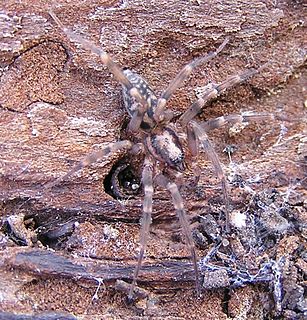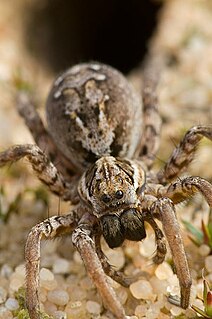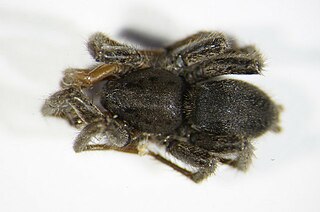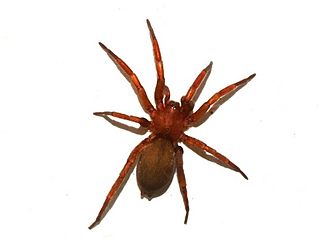
Liocranidae is a family of araneomorph spiders first described by Eugène Simon in 1897. They are one of several groups called "sac spiders". The holarctic genus Agroeca is the best-known, but it also includes various genera of more obscure spiders that still lack a diagnosis. Two species in the North American genus Neoanagraphis are found in the extremely dry conditions in the Mojave, Sonoran and Chihuahuan deserts. Females live in animal burrows while males wander and are the ones most often caught in pitfall traps.

Xysticus is a genus of ground crab spiders described by C. L. Koch in 1835, belonging to the order Araneae, family Thomisidae. The genus name is derived from the Ancient Greek root xyst, meaning "scraped, scraper".

Attulus is a genus of jumping spiders that was first described by Eugène Louis Simon in 1889. The name is a diminutive form of a common prefix for salticid genera, -attus.

Chalcoscirtus is a genus of jumping spiders that was first described by Philipp Bertkau in 1880. The name is derived from the Ancient Greek chalc-, meaning "copper", and scirt-, meaning "leap".

Pellenes is a genus of jumping spiders that was first described by Eugène Louis Simon in 1876. It is considered a senior synonym of Hyllothyene.

Alopecosa is a spider genus in the family Lycosidae, with about 160 species. They have a largely Eurasian distribution, although some species are found in North Africa and North America.

Drassodes is a genus of ground spiders that was first described by Niklas Westring in 1851. They are brown, gray, and red spiders that live under rocks or bark in mostly dry habitats, and are generally 3.8 to 11.6 millimetres long, but can reach up to 20 millimetres (0.79 in) in length.

Ozyptila is a genus of crab spiders that was first described by Eugène Louis Simon in 1864. It has been misspelled as "Oxyptila" in multiple accounts.

Pardosa is a large genus of wolf spiders, with more than 500 described species that are found in all regions of the world.

Zelotes is a genus of ground spiders that was first described by J. Gistel in 1848.

Gnaphosa is a genus of ground spiders that was first described by Pierre André Latreille in 1804. They all have a serrated keel on the retromargin of each chelicera.

Micaria is a genus of ground spiders that was first described by Niklas Westring in 1851. They are 1.3 to 6.5 millimetres long.

Berlandina is a genus of ground spiders that was first described by R. de Dalmas in 1922.

Haplodrassus is a genus of ground spiders that was first described by R. V. Chamberlin in 1922. They range from 3 to 10 millimetres. H. signifer is the most widespread species, found across North America except for Alaska and northern Canada.
Synaphosus is a genus of ground spiders that was first described by Norman I. Platnick & M. U. Shadab in 1980.
Psammitis is a genus of crab spiders first described by Anton Menge in 1876.
Spiracme is a genus of crab spiders erected by Anton Menge in 1876 to contain S. striata, transferred from Xysticus. The exact relationship of these spiders and their closest relatives has been long debated, and many included species have been transferred to and from similar genera, namely Xysticus and Ozyptila. Most recently, Rainer Breitling conducted a DNA barcoding study in 2019 and grouped similar species based on the results:













